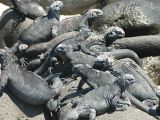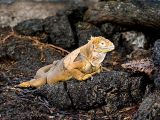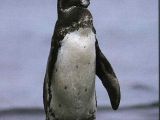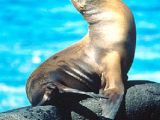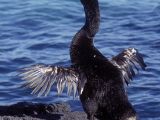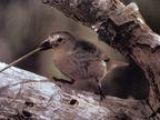In the Equatorial Pacific, between 90 and 91o V, and 1o 29' S, 968 km (605 mi) off western South American shore, at the same level with the Ecuador, to which it belongs, there's the the volcanic archipelago of Galapagos. It is formed by 18 greater islands (the largest being Isabella, 4290 square km, followed by Santa Cruz, Santa Maria, San Cristobal, San Salvador, Espaniola, Pinta and Fernandina), 42 islets and numerous rocks, having a total surface of 7,844 square km (3,000 square mi) spread over an ocean surface of 50,000 square mi (125,000 square km). Some islets are coral-made. The archipelago emerged just 5 million years ago!
The uninhabited islands were discovered in 1535 by the Spanish explorer Tomas de Berlanga. The dark green and gray basalt counts the story of the emergence of these islands from the ocean from incandescent lava, about four million years ago. Almost 2,000 craters exist in Galapagos. Some cones, eroded today, still have heights over 1,000 m (3,300 ft). The 60 craters and cones in San Cristobal raise over the lava plateau with just 20-30 m (66-100 ft). Most islands have steep cliffs and rough slopes that are hard to climb. Some of the volcanoes that formed the archipelago are still active. On Isabella, there are five smoking volcanoes.
Running waters are scarce and the dry clime (even if the islands are located on the Equator), did not encourage many people to settle here. The remoteness and isolation of the maritime routes turned the islands for a while in a pirate refuge and during the 18th century a stop for supply with tortoise meat for the whaling ships heading southward. Since 1833, the islands are administered by Ecuador under the name Colon (Columbus) Archipelago. In 1835, Charles Darwin spent 5 weeks here and got inspired for "The Origin of the Species". Today, only 6 islands have more stable settlements, made of fishermen, hunters, and goat/sheep herdsmen. But today, the islanders - about 17,000 persons - live mostly off the tourism.
In 1964, the Scientific Research Station "Charles Darwin" was founded. In 1968, the archipelago was declared a National Park, except some small sectors, to protect the unique endangered fauna. 750,000 hectares of the Isabella are protected. 10 years later, they were opened to tourism, but the too large influx of visitors imposed the establishment of an acceptable limit of 18,000 tourists annually and of obligatory routes. UNESCO declared in 1978 the Galapagos Patrimony of the Humanity.
Till the 80's the tourism has reached 100,000 annually, concentrated in July and August. A visit can last only 4-5 days. It is forbidden to bring food and drink on the islands, and smoking is also prohibited.
There are 5,555 species found in Galapagos, of which 1,903 (34.2 %) are endemics: 50 % of the birds, 32 % of the plants, 90 % of the reptiles, and 46 % of the insects.
On low land, the vegetation is comprised mostly of cacti and thorny bushes of Euphorbiacae, but on the higher parts of the large islands, there is an extremely different microclimate compared to that of the coast: the fog and the rain are more frequent, allowing an exuberant tropical vegetation made of Mimosa and daisy-related trees, but no palm trees. On some islands, there are bleak lava fields, spotted just by cacti. About 100 species of the Galapagos's flora are endemic. Some vegetation associations are specific only for some islands.
The strangest characteristic of these islands is given by a combination of South American and Antarctic fauna. The fauna is very distanced, a feature given by the presence of the giant tortoises, marine iguana, wingless cormorants, 14 Galapagos finches and other 63 endemic bird species (out of a total of 89 bird species).
The most emblematic species of the Galapagos is the giant tortoise (Geochelone nigra). Adults can weigh over 300 kilograms (660 lb) and their shell can be longer than 1.2 meters (3.9 ft); they also live at least 190 years. Even the name of the archipelago comes from them, as "galapagos" means "turtles" in Spanish. Similarly, large land tortoises are found only in the Seychelles archipelago (Indian Ocean).
They lay their eggs, as large as tennis balls, in the black sand of the beaches. Before the arrival of the people, only the land iguanas enjoyed this food. In some places, the passing of the tortoises between the feeding places and water springs carved paths in the rocks. The giant tortoises use "tortoise pools" for cooling down during the hot days.
During the centuries, sailors passing through the archipelago collected both eggs and adult tortoises, which could be kept on the ships for months alive without water and food, providing fresh meat. They were also hunted for their shell and oil. It is calculated that only in the 19th and the beginning of the 20th century, about 100,000 adult giant tortoises were killed. This led in the 50's to the situation in which only a several tens of tortoises had been left. Of the 13 races, two are extinct, and from the Pinta tortoise, only one male still survives, the famous lonesome George (thus this subspecies is doomed). Today there are about 15,000 Galapagos tortoises of the 10 left subspecies.
In Isabella only 6,000 tortoises are found. Fires menace this population, but also the poaching. Tortoise meat, especially that of the females, and their blood are considered to have therapeutic properties, besides being extremely nutritive. That's why 400 are now relocated in a special reserve.
Galapagos's marine iguana (Amblyrhynchus cristatus) is the only truly marine lizard in the world! Males can be up to 1.3 m (4 ft, 4 in) in length, weighing 3.5 kg (8 pounds). They dive and eat algae and weed from the sea bottom, but also those exposed by the low tide. From time to time, they eject through their nostrils a brine liquid, excreted by special salt glands, an adaptation that makes the iguanas cope with the salted sea water.
There is also a large species of land iguana (Conolophus), which reaches 1.5 m (5 ft) in length and 12 kg (26 pounds). This species is hunted for its skin.
The Galapagos finches inspired Charles Darwin, during his five weeks visit to the islands in 1835, to formulate later in 1849 the famous theory of the evolution of the species. With the lack of competition, a species arrived from South America gave rise to 14 species. The most famous of these species is the woodpecker finch, one of the very few birds known to employ tools (other examples are the Egyptian vulture and the New Caledonia crow). This finch employs sticks, using its beak, to get out from small tree hollows insect larvae.
Amongst the Galapagos's endemic bird species, except the finches, there is one penguin, one albatross, one cormorant, one dove, one gull, one buzzard, one owl and many smaller song birds. There are also endemic mice.
There was an enigma: how was it possible to encounter on Galapagos tropical species, like the iguanas, sea turtles, snakes, frigatebirds, boobies and tortoises, and at the same time cold clime species, native to the frozen Antarctic waters, like the penguins, sea lions, cormorants, albatrosses or the Galapagos's fur seal (Arctocephalus galapagoensis), which is the smallest of all seals. Galapagos penguin is the most northern penguin and the only one living on the Equator.
The explanation is found in the cold current of Humboldt (also called Peruvian), that ascends from Antarctica along the west coast of South America, and the equatorial contra-current that transports warm waters, leading to the paradoxical mix of species in the Galapagos.
Around the islands, there are layers of cold water alternating with layers of warm water, explaining how warm clime and cold clime species arrived. The waters around Galapagos are with 8-10o C colder than other equatorial sea waters, having temperatures of 16-22o C, while the sand of the beaches can have frequently 60o C.
Pigs, cats, rats and dogs introduced by the human colonists attacked local fauna, which had not experienced predation before and was defenseless, as the animals do not run out of the predators. Sailors released pigs during the 19th century, so that they would have food during their hops. Feral goats and donkeys compete with the land iguanas and the tortoises for food. The goats are extremely destructive for the vegetation.
Without predators, the goats have a fantastic reproduction rate: 3 individuals escaped in Pinta in the '50s produced in two decades a population of 40,000. Feral pigs are extremely menacing for the tortoises as they eat their eggs, localized by their fine olfaction. Pigs made in some islands that the hatching rate drop from 80 % to 3 %. Rats eat the tortoise offspring.
Cats and dogs attack the land iguanas. In the 70's, a group of dogs in Santa Cruz attacked and killed 500 land iguanas from a colony.
220 new species of introduced insects caused huge damages in the already affected flora by the introduction of 500 crop and ornamental plant species.
Besides the risk of over-population and over-tourism, the islands' unique fauna is menaced by overfishing, especially of the spiny lobster and sea cucumber. About 300 fishing ships are operated by the locals, not mentioning those coming from the continental Ecuador, US and Extreme East, which look for shark fins (for the infamous soup) and fur seal penises, considered aphrodisiacs...
13 endemic species are extinct, and 74 are endangered. Of the 35 reptile species, 3 are already extinct, and 12 are menaced. Of the 14 mammal species, 8 are already extinct, and 3 are endangered.
The 16 January 2001 oil spell of "Jessica", just 100 tonnes of petroleum, in the Galapagos produced huge damages to the marine iguanas, fur seals, pelicans, sea turtles, boobies, and albatrosses. The petroleum did not attack directly too many large animals,but it destroyed algae, food of the iguanas, and fish populations.
Fluctuations of the El Ni?o cause huge natural mortalities in the species depending on the sea resources, as their 'food' (fish, crustaceans, corals and algae) dies or gets scarce. In 1982-1983, this phenomenon cut to half the population of sea lions and sea birds and the sea iguanas were menaced with extinction, as the green algae on which they feed were replaced due to the higher temperatures by brown algae which they cannot digest. Instead, the rains boosted the the growth of the plants, the insect population and the insectivorous bird population.
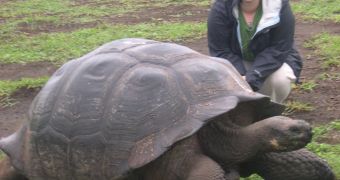
 14 DAY TRIAL //
14 DAY TRIAL // 
